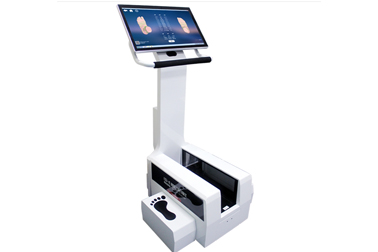The Role of Foot Scanners in Scanning Shoe Lasts
Shoe lasts are the core of shoe design and manufacturing, determining the shape, size, and comfort of footwear. With the widespread adoption of digital technologies, foot scanners play a crucial role in the creation and optimization of shoe lasts. This article analyzes how foot scanners are used to scan shoe lasts, including their principles, processes, and advantages, while exploring the value of these technologies in modern shoemaking.
Principles of Foot Scanners in Scanning Shoe Lasts
The working principle of foot scanners is to capture the three-dimensional geometric information of target objects (such as shoe lasts) and generate precise digital models. This process typically relies on the following technologies:
Optical Scanning
- Process: Projects laser or structured light onto the surface of the shoe last and captures the changes in reflected light to construct a 3D shape.
- Advantages: High accuracy; suitable for various materials and surface textures.
Contact Scanning
- Process: Uses a mechanical probe to contact the surface of the shoe last point by point, recording spatial coordinates to construct a complete 3D model.
- Advantages: Ideal for high-precision modeling, though scanning speed is relatively slow.
Non-contact Scanning
- Process: Uses multi-angle photography and photogrammetry to convert 2D images into 3D data.
- Advantages: Fast scanning; suitable for high-volume operations.
Steps for Scanning Shoe Lasts

Preparation Stage
Ensure the surface of the shoe last is clean and free from dust or debris to avoid impacting scanning accuracy.
Secure the shoe last on the scanner’s platform to ensure stability and facilitate comprehensive capture.
Parameter Configuration
Adjust the scanner’s resolution and scanning range based on the size, material, and shape of the shoe last to achieve optimal results.
For special materials (e.g., highly reflective surfaces), use matte sprays or other aids to reduce reflection interference.
Scanning Process
Activate the scanner and follow the preset path to comprehensively scan the shoe last, including the front, heel, sole, and vamp areas.
Capture data from multiple angles to generate complete point cloud data.
Data Processing
Import the point cloud data into a computer and use professional software to optimize it by removing noise, filling missing data, and creating high-precision 3D models.
Verify the dimensions of the generated 3D model to ensure accuracy and consistency with the physical shoe last.
Output and Application
Export the completed digital shoe last model in common formats (e.g., STL or OBJ) for use in subsequent design, analysis, or manufacturing processes.
Advantages of Using Foot Scanners for Scanning Shoe Lasts
High Precision
Foot scanners can capture intricate details of shoe lasts, producing 3D models with sub-millimeter accuracy, providing reliable data for shoe design.
Speed and Efficiency
Compared to traditional manual measurement or mechanical scanning methods, foot scanners offer faster scanning speeds, significantly reducing modeling time.
Digital Storage and Reusability
The generated 3D shoe last models can be stored long-term and reused in future design and production stages, lowering development costs.
Enhanced Design and Manufacturing
Digital shoe last models enable designers to quickly adjust shapes for precise customization. Additionally, the digital data can be directly utilized in 3D printing or CNC machining, improving manufacturing efficiency.
Applications and Future Outlook
Foot scanners are now a critical part of modern shoemaking, especially in scanning shoe lasts. Their application scenarios include:
Customized Footwear Production: Scanning shoe lasts to adjust shapes based on individual needs, providing customers with high-comfort footwear.
Mass Production: Using scanning technology to generate standardized shoe last models for large-scale production, ensuring consistency and efficiency.
Footwear Research and Innovation: Analyzing scanning data to optimize shoe last designs and develop new ergonomic footwear.
In the future, as scanning technology continues to evolve, foot scanners will become even more precise and efficient, offering smarter solutions for footwear manufacturing. This advancement will drive the industry toward digitalization and personalization.
